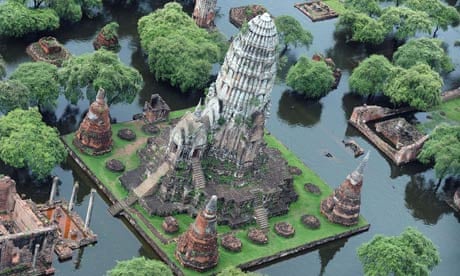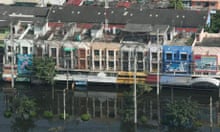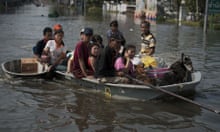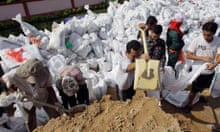For the second time in a year Bangkok is threatened by flooding and each time it seems to get worse. The prime minister, Yingluck Shinawatra, appeared on television earlier this month to warn that the situation had reached a "critical level" and that the flooding was the "most serious for decades". But the worst is certainly yet to come: after devastating 30 of the 76 provinces, claiming 252 lives and causing damage estimated at $3.3bn, water may invade parts of the capital this month. In the northern suburbs, homes, factories and roads are already under water.
The prime minister admitted that initial forecasts had fallen short of the most recent estimates, adding that if the water could not be diverted towards the sea the floods would do considerable damage.
Despite a sophisticated system of canals, reservoirs and locks, the 7bn cubic metres of water pouring towards the capital from the north can no longer be contained. The governor of Bangkok, Sukhumbhand Paribatra, reported that 90% of the lock gates had been opened, which should allow about 1m cubic metres of water a day to drain into the gulf of Thailand. "But if there is more rain Bangkok will probably be flooded," he warned.
There are always floods during the rainy season, but Bangkok is built on clay subsoil prone to subsidence. It is also under threat from the rising sea level caused by climate change and coastal erosion. Some Thai experts are predicting that part of Bangkok may be waterlogged by 2030. Other less alarmist analysts explain that flooding is a natural phenomenon, given that the city is built on marshy land only a metre and a half above sea level. But with rapid, often chaotic urban development, many buildings have gone up on farmland that used to soak up runoff.
Thailand is not the only country affected. In Laos, Cambodia and Vietnam, crops have been devastated, schools and hospitals destroyed and tens of thousands of people driven out of their homes. This month the death toll in Cambodia was 172, with 18 dead in Vietnam.
Thailand is the world's largest exporter of rice – 30% of the global market – and with 1m hectares of rice paddy damaged by floods, its economy is bound to be affected. "The whole region will suffer from the rise in food prices because potential crops have been devastated," said Margareta Wahlstrom, the UN assistant secretary general for disaster risk.
This article originally appeared in Le Monde




Comments (…)
Sign in or create your Guardian account to join the discussion